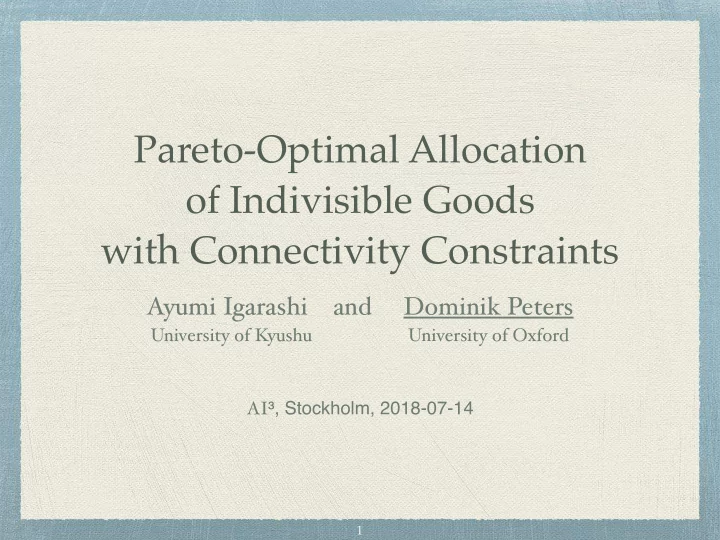

Pareto-Optimal Allocation of Indivisible Goods with Connectivity Constraints Ayumi Igarashi and Dominik Peters University of Kyushu University of Oxford AI ³ , Stockholm, 2018-07-14 � 1
Allocation of a Graph Finite set of indivisible items Agents have additive preferences over bundles of items Goal: Allocate items to agents Items are arranged in a graph, only allowed to hand out connected bundles � 2
Previously.. Fair Division of a Graph IJCAI-17, Bouveret, Cechlárová, Elkind, Igarashi, and P . NP-complete to decide existence of envy-free or proportional allocations, even on a path Tractable if there are few player types There always exists an MMS allocation if graph is a tree � 3
Pareto-Optimality A connected allocation is PO if no other connected allocation makes someone better off and no-one worse off. Without connectivity, standard way of achieving this: hand each item to agent preferring it most MMS exists on trees, so PO + MMS exists. Can we find it efficiently? Wait a minute, can we find PO efficiently? we allow 0 � 4
Finding some PO allocation On paths, version of serial dictatorship gives a PO allocation On general trees, (but welfare max. is hard) NP-hard (under Turing red.) to produce any PO allocation reduction from X3C via perfection pathwidth 3, diameter 7 ! d r a On stars, can use h . x a m . f l e w > = matching to maximise utilitarian welfare � 5
How to Show NP-Hardness PO always exists — so how to show hardness? Use technique from hedonic games H. Aziz, F. Brandt, and P. Harrenstein. Pareto optimality in coalition formation. GEB (2013) Suppose we can show that it is NP-complete to decide whether there is an allocation which is perfect . Then it is NP-hard under Turing reductions to find a PO allocation. � 6
Forests to Trees simple to find reduction showing hardness for forest (each player can only get one component) try to make reduction into a star — but center player can get two components! solution: everything x2, then make star — center player can only mess up one of the copies � 7
MMS Fair Division of a Graph [IJCAI-17] The maximin share of a player is ∈ mms i ( I ) = ( P 1 ,...,P n ) 2 Π n min max j 2 [ n ] u i ( P j ) . Intuition: Cut into n pieces, choose last. Maximise over connected partitions only => MMS values smaller than normal Adaptation of a moving knife protocol produces an allocation where every player receives at least their MMS share. � 8
PO + MMS MMS always exists on trees. Pareto-improvements preserve MMS. => PO + MMS exists on trees. Finding a PO + MMS allocation is NP-hard on a path Proof: take forest reduction, connect into path, add dummy players remains hard for ⍺ · MMS whose MMS guarantee for fixed ⍺ > 0 separate the pieces � 9
PO + EF1 0 0 0 1 1 0 0 0 1 1 1 0 0 1 1 1 e l p m a p x e r Σ e g g i b ∈ s i 2 e s r l e a h v t r e t n i m r o On paths, NP-hard to decide whether a f s ’ 1 e r e h w PO + EF1 allocation exists � 10
Future Directions Same thing for chores Restricted utility classes Welfare maximisation (approximations) Local envy-freeness: only envy bundles next to yours Approximate efficiency? Weaker concepts than PO? � 11
Recommend
More recommend